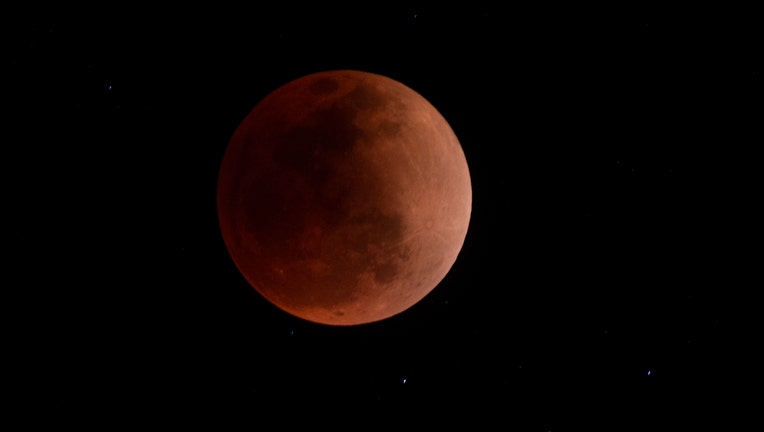How to see 'Blood Moon' lunar eclipse from Florida

The blood moon is seen during a total lunar eclipse in Canta, east of Lima on May 15, 2022. (Photo by ERNESTO BENAVIDES / AFP) (Photo by ERNESTO BENAVIDES/AFP via Getty Images)
The last total lunar eclipse for three years, more commonly known as the "Blood moon" is just days away from aligning in Central Florida skies.
What is a lunar eclipse?
A lunar eclipse happens when the sun, earth, and moon align so that the moon passes into the earth's shadow. When it comes to a total lunar eclipse, the "entire moon falls within the darkest part of earth's shadow, called the umbra" according to NASA. When the moon is within the umbra, it will turn a reddish hue — hence the nickname "Blood moon."

During a lunar eclipse, Earth’s atmosphere scatters sunlight. The blue light from the Sun scatters away, and longer-wavelength red, orange, and yellow light pass through, turning our Moon red. *This image is not to scale. Credit: NASA Goddard Space F
Can I see the Blood Moon from Florida?
Luckily, those living in North and Central America, as well as Ecuador, Columbia, and western portions of Venezuela and Peru will be able to watch the phenomenon.
The eclipse will also be visible in Asia, Australia, and New Zealand. Viewers in Alaska and Hawaii will have the opportunity to see every stage of the eclipse., NASA said.

A map showing where the November 8, 2022 lunar eclipse is visible. Contours mark the edge of the visibility region at eclipse contact times. The map is centered on 168°57'W, the sublunar longitude at mid-eclipse. Credit: NASA Goddard Space Flight Cen
When can I see the Blood Moon from Florida?
If you're an early bird, the timeline for viewing the blood moon will fit perfectly into your schedule. If you're not — you should probably set an alarm.
Beginning at 3:02 a.m. EST, the Penumbral eclipse will begin. During this time, the moon enters the earth's penumbra, the outer part of the shadow. Here, the moon will begin to dim, but the effect is quite subtle.
In the next hour at 4:09 a.m., the partial eclipse begins. At this point, the moon begins to enter earth's umbra and the partial eclipse begins. If watching from the earth, as the moon moves into the umbra, it looks like a bite is being taken out of the lunar disk, NASA said. Here, the part of the moon inside the umbra will look very dark.
If you happened to miss your first two alarms going off, have no fear, totality is here. At 5:17 a.m. EST, the entire moon will be in the earth's umbra — this is the moment totality will begin. The moon will turn coppery-red. NASA advises those watching to use binoculars or a telescope for a better view. You also want to use a camera on a tripod with exposures of at least several seconds.
Totality will come to an end at 6:42 a.m. The moon will exit earth's umbra, with the coppery-red color fading out. It will then look like a bite is being taken out of the opposite side of the lunar disk as before.
When can I see the next Blood Moon from earth?
The next total lunar eclipse is set to happen on March 14, 2025. Although it'll be three years until the next Blood Moon, partial and penumbral lunar eclipses will happen throughout that time, NASA said.

